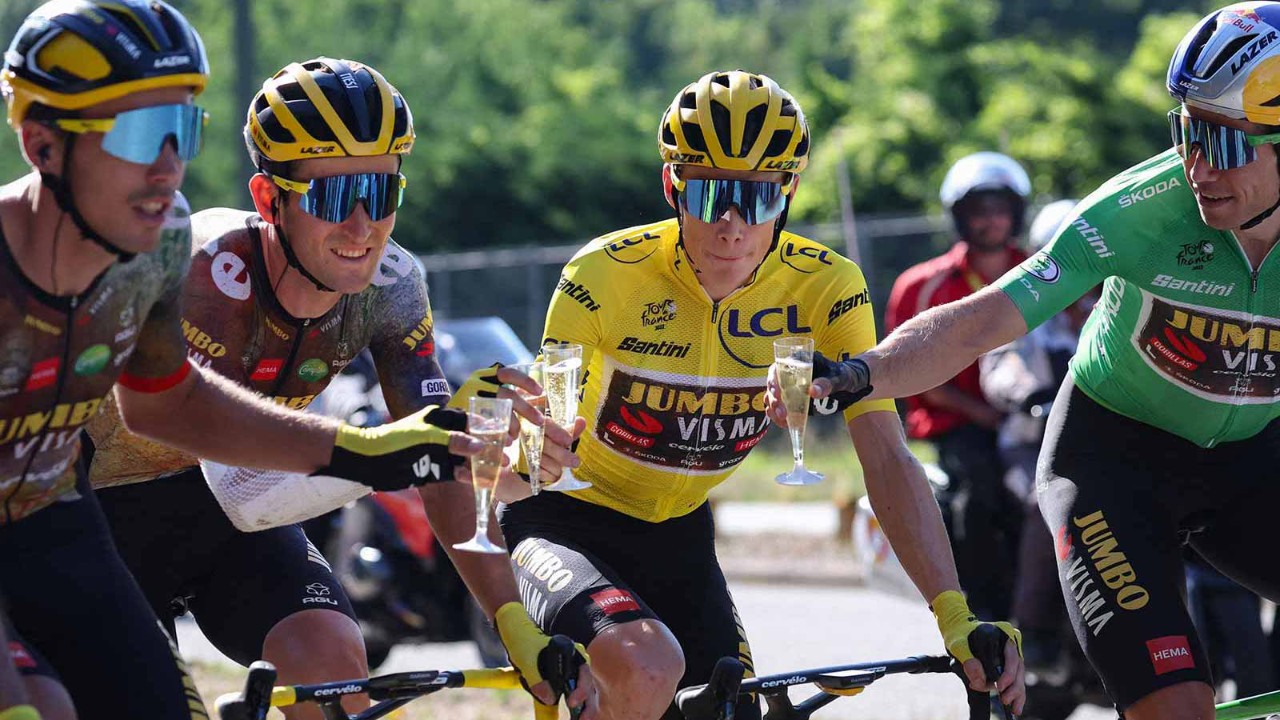
Riders competing in the 110th Tour de France will be lining up in Bilbao, Spain, for the ‘Grand Départ’ on 1 July, in the battle for the yellow jersey and the €500,000 (US$537,000) winner’s prize. This year the race celebrates its 120th anniversary (it was suspended during the two World Wars) with a total prize pot worth €2.3m (US$2.5m).
The Tour is privately owned by parent company the Amaury Sport Organisation (ASO), which also organises the Dakar Rally as well as golf and sailing events. ASO keeps the revenues of the Tour a closely guarded secret and there are no accounts specific to the race. However, 2020 company accounts for ASO showed total sales of €195m (US$209m) and a profit of €59m (US$63.4m). Of those revenues, it is widely acknowledged that the Tour generates the lion’s share – estimated at between €60m and €150m (US$161m).
ASO is a relatively small organisation operating the world’s most famous cycle race
Tour de France prize money
- Yellow jersey: €500,000
- Team classification: €178,800
- Stage win: €11,000
- Green jersey: €128,000
- KOM (polka dot) jersey: €108,700
- White jersey: €66,500
- Most aggressive rider: €56,000
By comparison, the Wimbledon tennis tournament generates £350m (US$435m) a year and the French Open generated US$255m in 2019.
Attractive investment
As such, it appears anomalous that ASO is a relatively small organisation operating the world’s most famous cycle race, at a time when the sports industry is increasingly seen as an attractive proposition for private equity investors. From football clubs and Formula One franchises through to rugby tournaments and tennis tours, the sports industry has become a popular hunting ground for buyouts.
Sport assets offer investors fast-growing companies with cheap valuations that have been hit hard by the pandemic. The question is whether ASO could be persuaded to sell a stake in the Tour or the whole enterprise.
In 2009, now-disgraced cycling superstar Lance Armstrong brought together a number of wealthy enthusiasts willing to help fund a potential acquisition of the Tour. Sources close to the discussions told the Wall Street Journal it would have cost in the region of US$1.5bn to buy the Tour at that time.
There are no suggestions that ASO would be willing sellers, but the potential for investment is clear to see.
Multiple revenue streams
Three financial pillars underpin the Tour: TV broadcasting rights, sponsorship and town hosting fees.
It is estimated that TV rights make up roughly half of race revenues. The contract with France TV is reportedly worth US$25m per year. France TV is the Tour’s principal domestic broadcaster and shares the main feed to broadcast partners including ITV (UK), ARD (Germany), TV2 (Denmark), ESPN (US), NBC (US), SuperSport (South Africa), Eurosport, BeIN Sports (Qatar), SBS (Australia) and Sky Sports (UK). By comparison, the BBC pays an estimated £60m (US$74.5m) a year for the rights to broadcast Wimbledon.
Locations are still willing to spend money to be included on the route, which changes every year
Advertising is the other major component, generating US$87.2m a year from its 42-brand partners, according to research by GlobalData. The biggest deals are linked to jersey rights with LCL, Skoda, E.Leclerc and Krys. LCL is thought to spend around US$12m a year to put its name on the yellow jersey, while Skoda could spend around US$4m on the green jersey.
Long-term relationship
The majority of sponsors have forged long-term relationships with the race. Tyre manufacturer Continental has sponsored the event since 2017 and last year extended the partnership to 2027. Ferdinand Hoyos, head of Continental’s tyre replacement business in Europe, the Middle East and Africa, said at the time: ‘The very important topics of road safety and a more sustainable future unite us and form the basis of our trusting cooperation.’
Town hosting fees provide the third and much less lucrative pillar. While the importance of fees has diminished, locations are still willing to spend money to be included on the route, which changes every year. ‘Start cities pay €90,000 [US$97,000] fees and arriving cities pay €130,000 [US$140,000],’ a spokesman for the Tour de France told AB. ‘As for foreign cities, it depends on the country and the host city. Logistical and organisation costs are not the same.’
A core feature of the race is that it is free for fans to attend, so there are no ticket revenues. Tour de France sources say that there are no plans for that to change. However, it’s an area vulnerable to change should an outside investor swoop in, particularly for the climax of the race in Paris.
The women’s race is also an interesting proposition for exploiting additional revenues, as witnessed in football and rugby union. ‘Women’s cycling is experiencing strong interest, as evidenced by the popular and television successes of Paris-Roubaix Femmes avec Zwift since 2020, and Tour de France avec Zwift last summer,’ a Tour de France spokesman told AB. ‘These successes are encouraging and deserve to be consolidated over time. Investments in women’s cycling will continue.’





